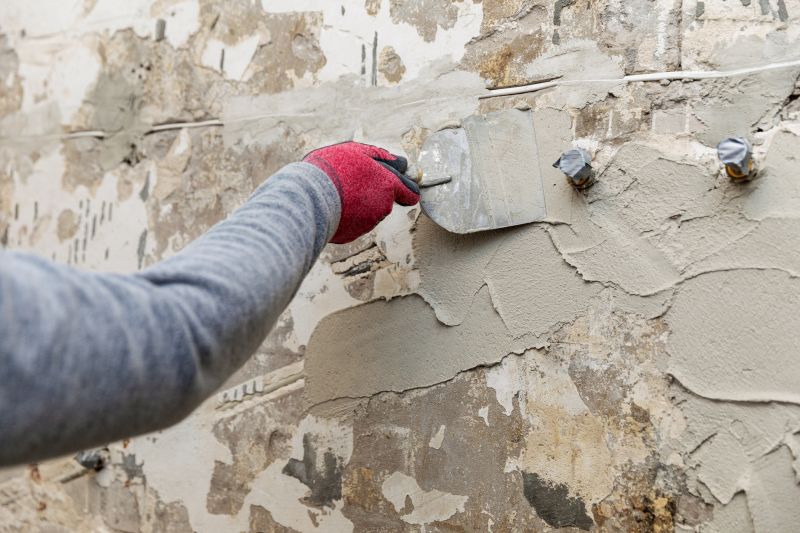Expert Picks For Essential Plaster Repair Tools and Materials
Get insights into the most recommended products that make plaster repairs straightforward and durable.
 Plaster repairs are a common aspect of maintaining and restoring the integrity of walls and ceilings in residential and commercial spaces. Whether addressing minor surface cracks or larger damaged areas, selecting the right products is essential for achieving a durable and smooth finish. The process often involves assessing the extent of damage, preparing the surface properly, and applying suitable repair compounds or materials. Using quality repair products can simplify the process and improve the overall appearance of the repaired area.
Plaster repairs are a common aspect of maintaining and restoring the integrity of walls and ceilings in residential and commercial spaces. Whether addressing minor surface cracks or larger damaged areas, selecting the right products is essential for achieving a durable and smooth finish. The process often involves assessing the extent of damage, preparing the surface properly, and applying suitable repair compounds or materials. Using quality repair products can simplify the process and improve the overall appearance of the repaired area.
Top Overall Option
Multi-Purpose Plaster Repair Compound
A versatile repair compound suitable for both interior and exterior applications, designed to bond well with various substrates, sand smoothly, and accept paint or texture finishes. Its ease of use makes it a popular choice for a wide range of plaster repair projects, from small cracks to larger damaged areas.
Types of Products For Plaster Repairs
Pre-mixed Repair Patches
Ready-to-use patches that adhere directly to damaged areas, ideal for quick fixes and minor surface repairs.
Repair Putty
A moldable or spreadable compound used to fill small cracks and holes, providing a smooth surface ready for finishing.
Bonding Agents
Primers or bonding liquids that enhance adhesion between old plaster and new repair materials.
Skim Coating Plasters
Thin-layer finishing plasters used to create a smooth, uniform surface over repaired areas.
Setting-Type Repair Mortars
Cement-based compounds that set quickly and are suitable for larger or structural repairs.
Textured Finish Plasters
Products that add decorative textures to repaired surfaces, matching existing wall finishes.
Waterproof Repair Compounds
Specialized materials designed to resist moisture and are suitable for exterior or damp areas.
Epoxy-Based Repair Kits
High-strength repair kits ideal for structural or load-bearing repairs, providing excellent adhesion.
Patch and Fill Kits
Complete kits with patches, fillers, and tools for comprehensive repair projects.
Lightweight Repair Plasters
Easy-to-apply compounds that reduce weight and are suitable for quick interior repairs.
Flexible Repair Compounds
Materials that accommodate movement and prevent cracking in areas prone to expansion or contraction.
Popular Choices
Widely used for various small-scale plaster repairs, offering ease of application and good adhesion.
Ideal for projects requiring quick turnaround, setting in a short amount of time with reliable results.
Designed for interior applications, providing a smooth finish for wall surface restoration.
Formulated to withstand outdoor conditions, suitable for sealing cracks and small holes on exterior surfaces.
Pre-mixed finishing plaster for creating a flawless surface prior to painting or wallpapering.
Suitable for substantial repairs and patching larger damaged areas, especially in structural contexts.
Designed for areas exposed to humidity or water, ensuring durability and resistance.
A flexible material that accommodates minor movements, reducing the risk of cracking reoccurrence.
Products that help match or create decorative textures on repaired surfaces for aesthetic consistency.
Prepares surfaces to improve adhesion of repair compounds, especially on slick or loose surfaces.
Different types of plaster repair products are designed to cater to various needs, from quick fixes to more extensive restoration projects. Some products are formulated for interior use, providing a seamless blend with existing plaster, while others are suitable for exterior applications where weather resistance is important. Proper surface preparation, including cleaning and priming, enhances adhesion and longevity of the repair. Additionally, selecting the right tools and following manufacturer instructions can make the repair process more efficient.
Advances in plaster repair technology have introduced versatile compounds that work well with different substrates and can be sanded, painted, or textured to match surrounding surfaces. For larger or more complex repairs, combining multiple products such as patching compounds, bonding agents, and finishing plasters can yield the best results. Regular maintenance and timely repairs can prevent minor issues from escalating into more significant structural concerns, preserving the aesthetic and structural integrity of walls and ceilings.
Overall, understanding the variety of products available and their specific uses helps in making informed decisions that suit the scope of the repair project. Whether tackling small cracks or extensive damage, choosing the appropriate materials and techniques can lead to smoother, longer-lasting results that enhance the appearance and durability of your spaces.
Key Buying Considerations
- Identify the extent and type of damage to choose appropriate repair products.
- Consider whether the repair is interior or exterior to select suitable materials.
- Check compatibility with existing plaster or wall surfaces for optimal adhesion.
- Evaluate drying and curing times to fit your project schedule.
- Opt for products that can be sanded, painted, or textured if finishing is required.
- Assess moisture resistance if repairs are in damp or outdoor environments.
- Determine if a quick-setting compound is necessary for faster repairs.
- Choose flexible or crack-resistant formulations for areas prone to movement.
- Review user instructions and safety precautions for ease of use.
- Consider the size of the repair project to select appropriately sized products or kits.
- Look for products that offer good adhesion and durability over time.
- Evaluate whether the repair product is suitable for structural or cosmetic repairs.
- Check for compatibility with existing finishes to ensure seamless blending.
- Prioritize products with good reviews for reliability and performance.
- Ensure the repair materials are suitable for the specific surface type, such as drywall, plaster, or concrete.
This page contains affiliate links. We may earn a commission if you purchase through these links, at no additional cost to you.
